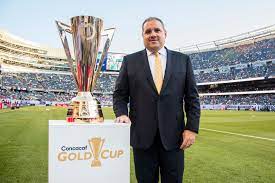By Paul Nicholson in Los Angeles
July 16 – Speaking ahead of the Gold Cup 2023 final in Los Angeles, Concacaf president Victor Montagliani has praised the increased level of competitiveness of his member nations and said that World Cup 2026 qualification is going to be fierce.
“This Gold Cup has shown that there are a clear four nations who have increased their competitiveness and who can realistically challenge the traditional elite (the US and Mexico) as equals. This hasn’t just happened, it has really been the work of six or seven years,” said Montagliani who also pointed to his own organisation having raised its own game in delivering these finals.
“World Cup qualification is going to be one hell of a battle and with the results we have seen, no one is guaranteed a place.”
Panama beat the US in the semis to qualify for their first final since 2013 and really cement themselves as the leading Central American team, a position held by Costa Rica in recent years, but who are in the process of rebuilding. Even so, despite exiting at the quarter final stage, they still showed signs that they are competitive.
Jamaica also have show an appetite for feasting at Concacaf’s top table, having been knocked out in the semi-final by a rejuvenated Mexico. If Jamaica had delivered in their opening group and completed what looked like a nailed-on win until the US grabbed a late equaliser against the run of game, then they would have won the group and taken a different route towards the final that would have avoided Mexico.
They look like they will only improve on this performance and still have more players to bring in from the Premier League to give themselves more squad depth.
Canada are perhaps the enigma. Having announced their arrival as elite performers with World Cup qualification, they have not been able to take the next step and win a title. They lost somewhat meekly at the Nations League final and at the Gold Cup looked like a team that had become a little uncomfortable in their skin – releasing their four key men back to their European clubs didn’t help that campaign that ended up with a quarter final knockout to the US.
But it is not just about what is now a big six in the region. There are other nations knocking on the door.
Montagliani points to the “French speaking nations who all performed well and were only a win away from being in the top echelon. It isn’t just about the Hispanic nations, but there is some great progress there.
“It was only four years ago that Guatemala were suspended. But since then they have embraced the ‘football first’ concept and Concacaf were all-in in terms of backing their return. They found the right people and got to work to make change. They were only a 1-0 loss away from the semi-final. That is huge progression,” Montaglini continued.
In 2021 the Gold Cup was staged as the region was coming out of covid. It was challenging in that covid travel regulations were very different between nations and full qualifying rounds for the group stages hadn’t been able to be played. That led to the introduction of the preliminary knock out rounds which were an immediate hit.
They enabled 12 teams to have a Gold Cup experience as well as qualify the final three teams for the group stages keeping a competitive integrity to the competition structure. The group stages were repeated again for this edition and will likely be kept going forward. The issue is whether having them so close to the Group Stage kick off, enables them enough recovery to be competitive.
Calendar was also an issue for the Nations League finals in that it was played just a week before the Gold Cup kicked off, ultimately meaning the US released 17 of their 23-player squad between competitions back to their European clubs. It was a move that backfired on the US no matter how much spin they try and put around giving an opportunity to other players.
The truth is that the Gold Cup was an opportunity to keep building a young and impressive team towards 2026 – how else are they going to prove themselves? That opportunity was lost and the US ended up with egg on their faces in front of their own fans and their colleagues in Concacaf.
But even with a US team struggling to catch the imagination of their own fans in their home market, this Gold Cup has seen an increase in attendances and behind the scenes Montagliani points to “significantly increased efficiencies”.
“I think the numbers on sponsorships and attendances will probably show we have had the best Gold Cup ever,” said Montagliani. “These are exciting times for our whole region on and off the pitch.”
There was talk about how the Gold Cup was a first test event for the World Cup in 2026 – a huge logistical task ahead of an expanded 48-team competition.
It actually it isn’t a test event for anything. It is the Gold Cup, a major event in its own right that celebrates the football and culture of a very diverse region, encourages it and embraces it. There is a lot FIFA could learn from that.
Tonight more than 70,000 people will fill one of the most impressive stadiums on the planet to celebrate that… and watch a really important game of football.
Contact the writer of this story at moc.l1745673438labto1745673438ofdlr1745673438owedi1745673438sni@n1745673438osloh1745673438cin.l1745673438uap1745673438
